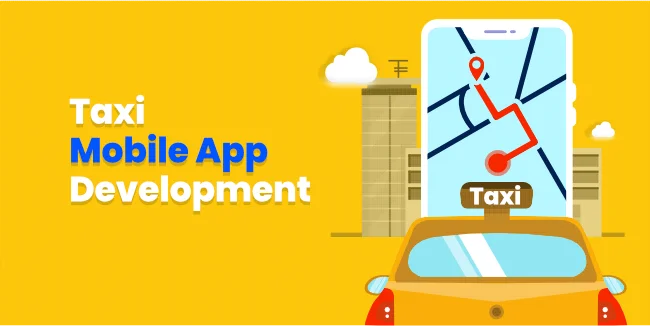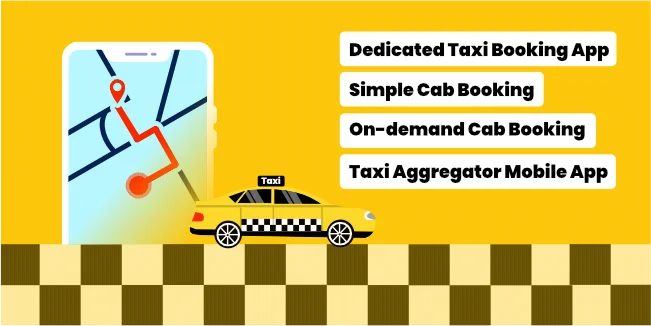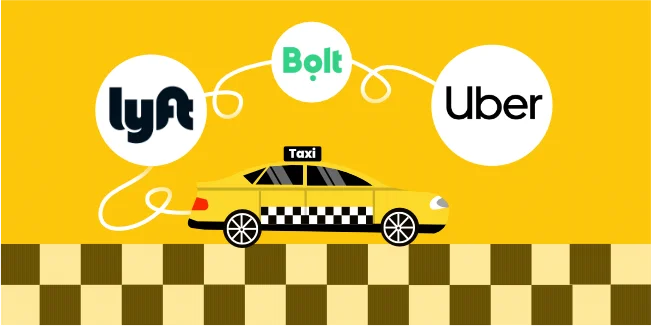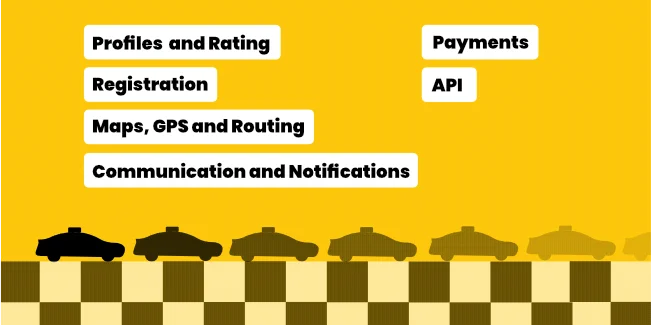Mobile Development
Business
taximobileappdevelopment
mobiledevelopment
Taxi Mobile App Development - Complete Guide

If you live in a big city, you likely know how difficult finding (and paying for) parking can be. Public transportation, taxis, and bikes are much more popular methods of transport because of this, not to mention the growing number of people who use services like Uber. So if you're looking to get into the transportation business, investing in a taxi booking mobile app development is your best bet.
In many places, especially huge cities, it has become popular to hire a taxi instead of owning your car. Hiring a taxi is cheaper than owning your car, and you don't have to deal with traffic jams or repairs.
In recent years, we have seen a massive shift in how people get around. Mobile apps like Uber, Bolt, and Lyft have made it easier than ever to get a ride with just a few taps on your smartphone. These companies have dominated the market and show no signs of slowing down anytime soon.
If you're looking to launch your taxi booking service and to get to know taxi app development services, there's no time like the present. This article will explore some of the best taxi apps on the market and how they are developed. We'll also take a look at the cost of taxi app development.
Taxi Booking App on Market
In recent years, taxi booking applications have become increasingly popular, which is expected to continue. Taxi apps are helpful for travelers and users as they provide several advantages.
The value of the taxi booking application industry was around $36 billion in 2017 and is projected to increase at a compound annual growth rate (CAGR) of 16.5% through 2025, reaching $126,521 million.
A recent example that comes to mind is Uber, which has made significant strides in a short amount of time and can now be used worldwide.
With rideshare services being affordable and easy to use, why do people still own cars? Take Uber, for example; it is currently worth $72 billion and growing rapidly. It's essential to draw up a marketing budget to promote the app in addition to the mobile app development cost.
How Does a Taxi Booking App Work?

A taxi booking app usually uses GPS (Global Positioning System) to figure out the customer's location who desires a taxi and then notifies the driver nearest to the customer.
After a customer requests a taxi, the driver nearest them receives a notification of the ride. If they accept, both parties are updated with each other's location and estimated arrival time.
While you develop a mobile taxi application, it's essential to consider all possible user stories and figure out which ones matter most. The insignificant ones can be disregarded.
You can then create a Minimal Viable Product (MVP), receive feedback, make the required changes, and continue until you succeed in the market as planned.
Challenges in Taxi Application Development Process
No development process is possible without difficulties to overcome. The key challenges we have faced as a taxi app development company are the following.
Car park Description
Depending on your business model, the driver app should be developed accordingly. If you have your car park, there is no need to approve cars. Still, if you follow the Uber-like model, the vehicles should be checked, and their photos provided. The drivers should deposit some money into their accounts.
Traffic
If a passenger requests to stop, for example, to smoke, how should the driver handle it? Our client prefers to automate this option.
However, we face the issue that GPS does not stop when a car has stopped; instead, it shows the movement as still being around a certain point.
In addition, we need to resolve the traffic congestion problem so that sensors don't incorrectly charge passengers for a slowly moving car.
Geolocation Inaccuracy
Google Maps is not an advanced enough technology to use for taxi applications. Taxi drivers in Ukraine rely on City Guide because it gives more accurate coordinates, locations, and addresses. Their local geolocation systems should also be investigated for other countries to compare with Google Maps and decide what would work best.
GPS Testing
To make sure the taxi service is accurate, we need to put it through some tests. We can simulate, take a real car, and test it live. When calculating the ride cost, that might be tricky- especially if it's a long distance with multiple stops or even to another city.
The cost of developing a taxi app depends on the challenges that need to be addressed and the features required in the final solution. This article will closely examine some key features typically included in taxi apps.
Types of Taxi Booking Mobile Apps

Choose the option that is more catered to your audience. While many people use taxis, we wanted to create an app solution for two popular platforms: iOS and Android, to keep our customers satisfied.
By catering your service to more than one platform, you risk spending too much on advertising without seeing results. For example, someone sees an ad and clicks on it intending to go to Google Play or App Store, but when they don't find what they're looking for, they leave immediately.
Just as there are different platforms you can build apps for, there are different types of taxi apps. Here are the most commonly created:
Dedicated Taxi Booking App
A taxi booking app is simply an extension of your current taxi business, designed specifically for businesses with a fleet of cars and drivers.
Consequently, by using their taxi service apps, these business proprietors make it more convenient for their patrons to book a ride and dilate their customer base.
In apps like these, customers just need to enter their location, pay the hourly fee, and choose their desired car. These apps require a server to manage numerous customer requests and quickly deliver taxis to customers.
Simple Cab Booking
This app aims to provide customers with an easy way to find and book different taxi services and view promotional material from these companies.
An app like this has to have the capacity for customers to call and book a taxi without any hassle. Plus, it would come with a map of all nearby destinations and an estimate of how much the ride would cost, considering factors such as price per unit, mileage, etc.
Some of the top advantages of these apps are that they don't necessitate a server. Although, you must frequently audit and update the app's database to stay on track with price changes.
On-Demand Cab Booking
An app like Uber requires a lot of infrastructure and investment. You must partner with taxi companies or drivers to use this app. These apps have many features accessible through two interfaces - one for passengers and one for taxi drivers.
For Drivers
They can save time and petrol by driving around the city looking for riders. They can wait in their car until a booking arrives and then depart to the desired location.
With the majority of payments now done online or through mobile wallets, drivers don't need to lug around a bunch of cash or change.
Drivers can rate and comment on each passenger, so if somebody is unpleasant in their car, they can save other drivers the same trouble by rating them accurately.
With GPS-enabled applications, drivers can more easily find their passengers without the hassle of having them wander or ask strangers for directions.
The driver can go directly to the specified location at the time of booking, so there's little chance of wasting any time.
For Passengers
The app tells passengers the cab's location and how long it'll take to get there so they can use that time for something else.
After booking their journey online, passengers can easily travel, knowing they don't have to carry any cash. Instead, they can use their debit or credit card to pay through the app or link their digital wallet.
The app also allows users to rank and review their cab drivers, providing a transparent system.
Instead of waiting on the street for a cab, people can use apps to order one ahead of time.
Taxi Aggregator Mobile App
The type of taxi booking service app that Uber operates is meant for those new to the business rather than people who already own a fleet of cars. The benefit of this mobile booking system is that it's available for anyone with a smartphone. There are two primary ways of using it – simple and complex.
Top Taxi Booking Apps

Uber is undoubtedly the first taxi-booking app that comes to mind. It has truly revolutionized the taxi industry and beyond. The term "Uberization" has entered our vocabulary, and Uber's influence can be seen in many different areas of life.
Uber
Uber is one of the most well-known taxi booking apps, but Taxi Magic (Now Curb) first sparked this idea. Regardless, Uber quickly gained popularity as it expanded to various countries. Uber has received $25.2 B in funding from investors over the years.
On-demand services have become increasingly popular in recent years, thanks to Uber. According to AngelList, Uber is valued at approximately $70 billion and provides a range of on-demand services, from food delivery to taxi booking.
- Set pickup location,
- Choose one of the available car types,
- See the approximate time of arrival and monitor your car as it approaches,
- Add your credit or bank card, which will be automatically used to pay for the ride.
Bolt
Bolt, previously known as Taxify, is a popular taxi-booking app based in Estonia that allows users to book fast and affordable rides anywhere and anytime. So far, the company has received $1.3 billion in funding and has over 10 million passengers and 500 thousand drivers in 25 countries, including Latin America, Spain, and Portugal.
With this ride-sharing app, riders can see the price of their ride before booking it and know how they will pay. Riders can also set their pickup location without knowing the exact address. Plus, at the end of the ride, riders can rate their driver to give feedback and help improve service quality for future users.
- Set the destination,
- Know the cost of the ride upfront,
- Rate the riding experience and the driver,
- Pay in the app.
Lyft
Did you know that Lyft originally came with the ride-sharing feature, not Uber? They're in stiff competition, but Lyft is well-known and considered the best taxi app in Canada and the US. It's installed on nearly 65% of all smartphones in those countries.
Lyft obtained a sizable market share in just a few years, increasing from 22% to 39%. According to Forbes, the company plans on continuing this trend. The management does its due diligence by ensuring that all drivers undergo a comprehensive background check to ensure that users are safe.
By providing an advanced mapping system, the app allows users to easily track their drivers and get details about them in advance. The app offers three transport options: Lyft, Lyft Plus, and Lyft Line.
Lyft allows users to travel alone or with up to 6 people. It is slightly more expensive than its competitor, Uber. Still, it has positioned itself as a premium brand with high-demand cabs.
Like Uber, most of the features and user interface are offered on this app; however, tips can only be paid in the destination payment at the end of each trip. With a similar ride-sharing market emerging, both companies offer a competitive service.
- Book a ride with a finger tap on the screen,
- Track his car in real-time and see the estimated time of arrival,
- Pay directly from the app,
- Share rides with professional, high-rated drivers.
Features Of An Taxi App

Many companies have different taxi booking apps for drivers and passengers. So, we will show you how to create a taxi booking app catered to both groups.
API
Many people mistakenly believe that developing an app means writing code. While this may be the case for simple apps, most applications are developed as part of a larger service and thus represent only a small portion of the total work involved.
API development starts with outlining all potential scenarios for client interaction with the service. These are used to plan and build the API. Only after every possible automated process has been considered can we start developing it. With an API in place, it will be easy for you to integrate new client apps regardless of the platform they're built on.
By following this approach, you can conserve time and essential resources while making it much easier to expand service in the future.
Registration
By offering your users a One-Time Password registration, you are making it easier and safer for them to use your app. The user only has to enter their mobile number to receive a randomly generated password in this registration type. This password is then automatically inserted into the input field within the app, thus saving time and simplifying the process overall.
The process is fast and easy, taking only seconds to register the client in the app for future use.
Mobile number is the critical feature taxi service needs to interact with a client, so it's incredibly convenient.
Users only have to input their phone number once using OTP registration. This number will be used later for order confirmations, notifications, and driver communication.
Maps, GPS, and Routing
GPS is used to determine the current location of a user's device. With maps and positioning, users can easily find their car. If you need to calculate travel duration and build routes, a routing server is required.
The road quality monitoring app UARoads is available for Android, iPhone, and iPad. We chose to use OpenStreetMap's (OSM) database for this project.
We suggest you use the native maps available on the client's platform to reduce development costs. For example, Google Maps are a natural choice for Android devices.
Communication and Notifications
Taxi app developers can save users time by allowing them to choose their favorite type of car or other preferences, like cars that will enable smoking or traveling with pets.
The passengers and the drivers or managers should then be able to contact each other securely to discuss all the details. Keeping users' private data secure is of utmost importance. The phone numbers should be kept secret to maintain privacy.
SMS and push notifications to inform users about significant events, like when their rental period is nearing its end or their taxi has arrived
Although push notifications are a breeze to set up, SMS requires integration with a communication service provider. Uber works with Twilio, but there are other similar companies, such as Nexmo or Sinch.
Payments
Making it easy for users to pay for their taxi rides is essential in today's market. Offer your passengers various payment options to make things more convenient for them.
A taxi booking app development company can integrate payments with systems like Braintree, WorldPay, or Stripe. There are also several other services available out there for bank cards payments, such as Payfirma.
Remember to include tips in your taxi and car booking mobile app development!
Profiles and rating
Profiles and ratings are essential features that help maintain a vibrant community by ensuring everyone is happy. You can identify early problems with customer satisfaction by closely monitoring your drivers' and cars' ratings. Allowing drivers to rate passengers can make this process even more valuable.
Conclusion
People are ditching public transportation and opting for ride-sharing apps at an unprecedented rate. If you're not already on the app bandwagon, plenty of options are available.
You may make a significant impact by offering an upgraded service that differentiates your taxi booking app from the competition. Keep in mind that developing a taxi booking app requires a substantial financial and time investment; therefore, finding qualified and trustworthy taxi app developers is critical.